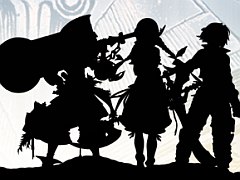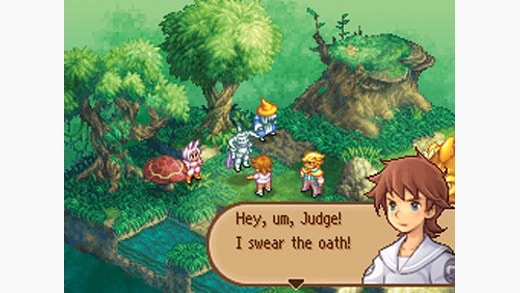You can trust VideoGamer. Our team of gaming experts spend hours testing and reviewing the latest games, to ensure you're reading the most comprehensive guide possible. Rest assured, all imagery and advice is unique and original. Check out how we test and review games here
I have a confession to make. I have always been something of a Final Fantasy sceptic. There, I’ve said it and there’s no going back now. My apologies to the Final Fantasy fanatics out there but the thought of spending hour after hour mired in turn-based fighting, grinding through random battles and obsessing over stats and jobs and spells is enough to send me scuttling to the comparative safe haven of the Legend of Zelda series. In comparison Final Fantasy has always seemed just a little, I don’t know…obsessive-compulsive? However Final Fantasy Tactics A2: Grimoire of the Rift has done the seemingly impossible. It has won me over. A bit.
You play as Luso Clemmens, a mischievous, headstrong and plucky young boy. On the last day of term Luso is sent down to the library to help clean up and finds himself alone with an ancient tome laying open on the table. Like the best troublesome schoolboy he proceeds to graffiti his name across the pages and is immediately transported to a strange, enchanted land and right into the middle of a battle with a giant chicken.
Like Final Fantasy Tactics Advance on the GBA, Grimoire of the Rift concentrates pretty much solely on turn-based battles. Your clan of warriors pick up quests in the local pubs and then head out into the wider world to do battle with the men and monsters of Ivalice, increasing stats and gaining powers with every fight. Out of the fifteen or so quests available at any one time only one will really advance the plot, with the remaining sorties serving as side quests and helping to build up your team.
The battles take place over all types of terrain that can either help or hinder your band depending on the tactics you employ, and this is where the true joy of the game comes in. Pitting your wits against not only the foes at hand but also your surroundings, using them to your advantage and being able to swing a battle by claiming the high ground or slinking round the back and clobbering someone is incredibly satisfying. So much so that you’ll find yourself seeking any excuse to nip off and get another battle under your belt.
Before each skirmish judges descend into the arena to lay down the law for the forthcoming battle and allow you to choose a small bonus (such as slightly increased power or luck) for following the rules. Adhere to the law and you’ll receive an extra item at the end, break it and you won’t be able to revive any of your fallen comrades for the rest of the battle. While this initially seems like petty bureaucracy you soon realise that these laws are included to make you think even more tactically during the fight. For instance, one law bans players from attacking units with lower HP than themselves. This leads to the judicious hacking of members of your own team in order to lower their health just enough to finish off the enemy and forces you to think three or four moves ahead in order to ensure victory.
Looks wise the presentation is never less than slick with some great magic, attack animations and intricate backgrounds. The score also deserves a mention; bounding along at a spectacular pace it lends the quests an extra kick in the guts and helps to make even the mildest move or spell a work of epic heroism.
Unfortunately there are a few petty frustrations that make this a good game rather than an outstanding one. Firstly the touch screen controls are a nightmare and I can guarantee that you will be stowing the stylus and using the buttons within 10 minutes of play. It is painfully obvious that the control system was a last minute addition to the European release. While this makes no difference to the gameplay it does feel like Square Enix has missed an opportunity to do something interesting (or at least competent) with the controls.
The view also gets a little too clustered for comfort at times which can lead to a few ‘friendly fire’ type incidents while you get used to the set up. To the inexperienced the trading system and ‘bazaar’ feature, where you trade items found in battle or gained along the way for the possibility of buying new equipment, is far from intuitive. Finally, to be honest, the range of statistics on show at any one time is a bit much. I’m sure that there are people out there who can absorb that much raw data and make it mean something (I’m thinking along the lines of Professor Stephen Hawking here) but to us regular folk without a degree in advanced statistical mathematics it’s simply excessive. It’s probably best to leave it to the DS to do the calculations, providing that you trust your DS to play fair that is. There are a few moments in the game where you unleash what you’re sure is a devastating blow only to be told that you have done minimal damage to your opponent’s HP. Hmmm.
Despite these minor grievances Grimoire of the Rift is a deep and involving game, with excellent presentation and a great sense of scale. Give it an hour or two to learn the basics and get your clan to a vaguely competent level and it will then proceed to eat your life. With over 300 missions, upwards of 70 hours of gameplay and two (yes two!) difficulty settings you will slowly lose your job, lose your girl/boyfriend and your social life will shrivel and die like a salted slug-beast. Fact.
Final Fantasy Tactics A2: Grimoire of the Rift
- Platform(s): Nintendo DS
- Genre(s): RPG, Strategy, Turn Based

/https://oimg.videogamer.com/images/bcc8/final_fantasy_tactics_a2_8.jpg)






